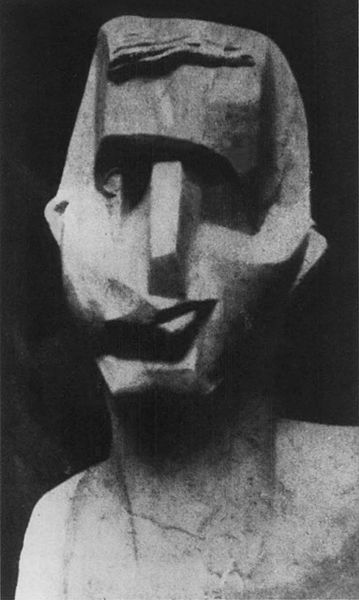Danseuse, also known as Femme à l'éventail, or Femme à la cruche, is an early Cubist, Proto-Art Deco sculpture created in 1912 by the Hungarian avant-garde sculptor Joseph Csaky (1888–1971). This black and white photograph from the Csaky family archives shows a frontal view of the original 1912 plaster. Danseuse was exhibited in Paris at the 1912 Salon d'Automne, an exhibition that provoked a succès de scandale and resulted in a xenophobic and anti-modernist quarrel in the French National Assembly. The sculpture was then exhibited at the 1914 Salon des Indépendants entitled Femme à l'éventail ; and at Galerie Moos, Geneva, 1920, entitled Femme à la cruche.
Danseuse (Csaky)
Joseph Csaky, 1913, Tête d'homme (Head), 1913, plaster, lost or destroyed. Photo published in Montjoie, 1914, and André Salmon, Le Salon, published in Montparnasse, 1914
Joseph Csaky was a Hungarian avant-garde artist, sculptor, and graphic artist, best known for his early participation in the Cubist movement as a sculptor. Csaky was one of the first sculptors in Paris to apply the principles of pictorial Cubism to his art. A pioneer of modern sculpture, Csaky is among the most important sculptors of the early 20th century. He was an active member of the Section d'Or group between 1911 and 1914, and closely associated with Crystal Cubism, Purism, De Stijl, Abstract art, and Art Deco throughout the 1920s and 1930s.
Joseph Csaky in 1926
Joseph Csaky, 1911–12, Groupe de femmes, plaster lost, photo Galerie René Reichard, Frankfurt. Exhibited at the 1912 Salon d'Automne, and Salon des Indépendants, 1913, Paris
Joseph Csaky, 1912, Danseuse (Femme à l'éventail, Femme à la cruche), original plaster, exhibited at the Salon d'Automne of 1912, Paris, n. 405, and Salon des Indépendants of 1914, n. 813, photo from Csaky archives AC.110
Joseph Csaky, Head (Tête d'homme), 1913, Plaster lost. Photo published in Montjoie! March 1914, also Richard, René, 1988




